Hasta Yoga Mudras ( Hand Gestures ) are special hand gestures used in Kundalini Yoga and other yoga practices that help to promote inner and outer balance and well-being. They have been used for centuries and are believed to help draw energy from the universe, helping to restore harmony and balance. With yoga mudras, practitioners can tap into the powerful energy of the universe and use it to improve physical, mental, and emotional health. By understanding the power of yoga mudras and learning the 22 essential hasta yoga mudras, you can begin to experience the benefits of improved health and well-being.

Five Elements & Mudras
Illnesses are brought about by an unbalance in the body, which is brought about by an absence or abundance of any of the five elements air, water, fire, earth, and space.
Each of these five components has an unmistakable and fundamental job inside the body, and our fingers have the qualities of each of them. When a finger speaking to one of the components makes contact with the thumb, that component is adjusted.
Consequently, the unbalance-caused ailment is treated. Mudras change vitality stream, changing the equalization of air, fire, water, earth, and ether, accordingly encouraging mending and wellbeing recuperation.
Today, we’ll investigate a portion of the most powerful mudras for curing ailments.
- The index finger speaks to air (Vayu),
- The thumb finger speaks to fire (Agni),
- The little finger speaks to water (Jal),
- The ring finger speaks to earth (Prithvi),
- The center finger speaks to space (Akash).
What are Hasta Yoga Mudras?
Hasta mudra is a hand gesture used in yoga and meditation to promote balance and healing. There are several types of mudras, but the most common and useful ones for health include Vayu (air), Agni (fire), Varun (water), Prana (energy), Jnana (wisdom/knowledge), and Chinmaya (awareness/consciousness).
To do a mudra, first place both hands in any position you like (such as on your knees, palms down, or on your thighs), and then interlace the fingers. You can keep the fingers straight or bend them slightly.
Each mudra has a specific purpose and is beneficial in its way. When performing these hand gestures, you should hold them for a few minutes or as long as you can while comfortably maintaining the position.
Benefits of Practicing Hasta Yoga Mudras
Hasta Yoga mudras can benefit people of all ages, including children. Yoga is beneficial for both mental and physical health, such as reducing stress levels, relieving anxiety, and improving concentration.
Yoga can also help with sleeping disorders, such as insomnia, and can aid in improving self-esteem. Yoga provides a holistic approach to living and can help us to stay healthy and happy.
When applied correctly, Hasta yoga mudras can help to treat a wide range of health problems, including back pain, knee pain, headaches, migraines, and high blood pressure. They can also help to improve your mood and sense of well-being and can help you to live a more balanced, healthy, and happy life.
22 Essential Hasta Yoga Mudras
Hasta Yoga mudras are special hand gestures used in yoga practices that help to promote inner and outer balance and well-being. Here are the 22 essential hasta yoga mudras: –
- Jnana/Gyan Mudra (Psychic gesture of Knowledge & Consciousness)
- Chinmaya Mudra (Psychic gesture of Awareness)
- Vayu Mudra (Gesture of air element)
- Agni Mudra (Gesture of fire element)
- Varun Mudra (Gesture of water element)
- Prana Mudra (Psychic gesture of life force)
- Shunya Mudra (Void or empty Psychic gesture)
- Surya Mudra (Gesture of sun element)
- Prithvi Mudra (Psychic gesture of earth element)
- Adi Mudra ( First Gesture)
- Anjali Mudra (Gesture of reverence)
- Dhyana Mudra (Psychic gesture of meditation)
- Shakti Mudra (Psychic gesture of power)
- Hakini Mudra (Sacred Hand Gesture)
- Apāna Mudra (Psychic gesture of life force)
- Poorna Mudra / Brahma Mudra (Gesture of full breath)
- Yoni Mudra (Attitude of the womb or source)
- Bhairav Mudra (Fierce or terrifying attitude)
- Hridaya Mudra (Heart gesture)
- Vishnu Mudra (Hand gesture of Lord Vishnu)
- Granthita Mudra (Knot gesture)
- Mahasir Mudra (Great head gesture)
(1) – Jnana/Gyan Mudra (Psychic gesture of Knowledge & Consciousness)
The Jnana/Gyan mudra helps to keep you focused and relaxed while meditating, and is associated with the element of the sky.
This mudra is relatively simple, yet it immensely helps increase concentration and wisdom; All you have to do is connect the thumb and index finger. Let’s learn the formation of Jnana mudra/Gyan mudra step by step:

How to do Jnana/Gyan Mudra
- To perform the Jnana mudra or Gyan Mudra, you can sit in any position, such as Sukhasana (cross-legged) or padmasana.
- Place your hands together in a loose fist-like formation.
- Now, join the tip of the index finger and thumb together, putting gentle pressure and straighten the remaining three fingers, keeping them relaxed and slightly apart.
- Keep your hands on your knees. The palms should face up, and the hands and arms should be relaxed.
- Bring your attention to your breathing while you are doing Jnana/Gyan mudra, and try to clear any thoughts from your mind.
- It will enable you to block out any external distractions that may otherwise be a source of anxiety.
Benefits of Jnana/Gyan Mudra
- Gyan mudra may help increase memory, creativity, and concentration by increasing blood flow to the brain.
- Jnana Mudra helps to steady the constantly restless mind. This can help improve focus.
- It helps strengthen the muscular system and improves digestion.
- Jnana Mudra helps to reduce stress and anxiety.
(2) – Chinmaya Mudra (Psychic gesture of Awareness)
The Chinmaya mudra helps to balance your energy and is associated with the element of water. It is known as the Gesture of Awareness because it is believed to bring outward flowing awareness back into the body. This mudra is also known as the gratitude gesture because it is said to increase feelings of gratitude and appreciation.

How to do Chinmaya Mudra
- To perform the Chinmaya mudra, gently bring together the tips of your thumb and index finger to form a circle.
- Curl the other three fingers inwards into the palm.
- Place the hands on the knees and palms either upwards or downwards.
- Keep your eyes closed and focus on your natural flow of breath.
- This mudra can be done with both hands, or it can be done with one hand at a time.
Benefits of Chinmaya Mudra
- Chinmaya Mudra helps you to create awareness of the breath which helps in the smooth flow of prana energy in the body.
- This mudra helps in removing the mental chaos. It has a calming and soothing effect on your mind and body and has been known to help with insomnia.
- It also promotes feelings of gratitude and appreciation, allowing you to have a greater appreciation for the things in your life that are good.
- The Chinmaya mudra can be done anywhere, any time, and is a great way to focus the mind and bring about feelings of calm.
(3) – Vayu Mudra (Gesture of air element)
Vayu mudra, or the hand gesture that controls the body’s air element, is great for healing and relaxing by removing harmful excess air produced in the body. It is believed to promote self-healing by directing the flow of prana.

How to do Vayu Mudra
- Sit in any comfortable yoga pose like Sukhasana or Padmasana.
- Put your hands on your knees with the palms facing upwards.
- Fold the index finger inwards such that it touches the base of the thumb. Keep the other fingers straight.
- Apply light pressure to the index finger with your thumb.
- The pressure may feel slightly uncomfortable initially, but it will subside over time.
- Hold the pose for a few minutes, calmly focus on your breathing, and chant any mantra you choose.
Benefits of Vayu Mudra
- Vayu mudra helps in balancing the Vata dosha associated with the air element.
- The Vayu mudra is a great way to promote healing and can be used to relieve pain.
- It is also helpful for people who are experiencing symptoms of anxiety or insomnia.
- The Vayu mudra helps cleanse the body and remove toxins through the hands.
(4) – Agni Mudra (Gesture of fire element)
The Agni mudra is excellent for body purification and is associated with the element of fire. Performing Agni Mudra restores the fire balance in the body and activates the fire energy.

How to do Agni Mudra
- Start by sitting in a comfortable yoga asana with the back straight.
- Move the tip of the ring finger such as it meets the base of the thumb. Straighten the remaining three fingers, keeping them relaxed and slightly apart.
- Put slight pressure with the thumb on the back of the ring finger.
- Keep your hands on your knees with the palms facing upwards and sit in this position for 30 minutes or until it feels comfortable.
- The best time to do Agni Mudra is in the morning on an empty stomach.
Benefits of Agni Mudra
- The Agni mudra is effective for cleansing the body and removing toxins.
- It is great for bringing more energy to your body and can help reduce feelings of fatigue.
- This mudra can also be beneficial for improving digestion, and it is often used in Ayurveda treatments.
(5) – Varun Mudra (Gesture of water element)
Varun Mudra is an excellent hand pose that promotes and balances the water content in the body. It is associated with the water element.
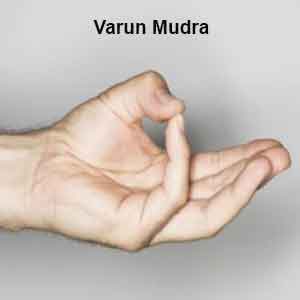
How to do Varun Mudra
- To perform varun, sit with your spine straight in a comfortable yoga posture such as Sukhasana.
- Make Varuna Mudra by straightening your fingers and bending your little finger towards the thumb so that the tip of the thumb touches the tip of the little finger.
- Keep the rest three fingers straight. Make this mudra with both hands.
- Practice Varuna Mudra daily for at least 30 minutes, either in one go or 2-3 rounds of 10-15 minutes each throughout the day.
Benefits of Varun Mudra
- Varun mudra balances the water element and therefore keeps the body hydrated.
- Varuna Mudra’s practice helps balance Vata dosha, which ultimately helps cure problems like dehydration, dry eyes, dry skin and joint pain.
- The Varun mudra also helps you to concentrate and quiet your thoughts.
- It is a very effective way to help you meditate and can also help with insomnia.
- The Varun mudra is commonly used for healing and can help promote feelings of tranquility and calmness.
(6) – Prana Mudra (Psychic gesture of life force)
Prana is the vital life force present in the body. The Prana mudra, as the name suggests, enhances and channels the prana of the body. It is great for grounding and healing and is associated with the element of earth, water, and fire.

How to do Prana Mudra
- Sit in a comfortable position, either on the ground or in a chair.
- Extend your hands outwards and rest them on the thighs keeping the palms facing up.
- Now keep the index and middle finger extended, and touch the tip of the thumb with the ring finger and little finger.
- Focus on breathing deeply and visualize the free flow of prana, the pure and revitalizing life force in the body.
You should practice Prana Mudra for at least 30 minutes daily to get maximum benefits. You can do it all at once or break it into three short 10 to 15 minute spans.
Benefits of Prana Mudra
- The Prana mudra helps bring more energy to your body and brings your mind into a state of calmness.
- It is also beneficial for healing both physical and mental wounds.
- The Prana mudra is often used in meditation practices and can help promote peace and relaxation.
- You can also use Prana mudra to help clear your mind and focus on the present moment.
(7) – Shunya Mudra (Void or empty Psychic gesture)
The Shunya mudra is a hand gesture that focuses on limiting the space element in the body. It is great for stress relief and relaxation and is associated with the space (akasha) element.
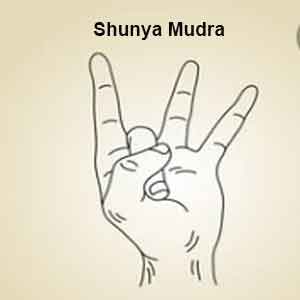
How to do Shunya Mudra
- Sit in any comfortable Yoga position, such as Sukhasana or Padmasana.
- Keep your spine straight.
- Now keep both your hands on the knees so that the palms remain upwards.
- Now bend your middle finger towards the base of the thumb. Ensure that the tip of your middle finger touches the base of the thumb.
- Next, place your thumb on top of your middle finger. Keep the other three fingers straight.
- Focus on your breathing while keeping your eyes closed.
Practice Shunya Mudra with both hands for 30 consecutive minutes every day or for 10 minutes three times a day.
Benefits of Shunya Mudra
- Shunya Mudra may help ease various physical ailments such as ear pain, hearing loss, tinnitus, throat problems, motion sickness, etc.
- The Shunya mudra helps calm the mind and brings clarity to any situation.
- It is also beneficial for releasing tension and stress and promoting inner peace and balance.
- The Shunya mudra can also be used to help clear the mind of unwanted thoughts or distractions, allowing you to focus on the present moment.
- In Ayurveda, Shunya Mudra is recommended as a healing pose for people with predominant Vata dosha.
(8) – Surya Mudra (Psychic Gesture of sun)
The Surya mudra is associated with the element of fire and is great for increasing energy levels, improving metabolism, and boosting the immune system. It is also called Agni Mudra.
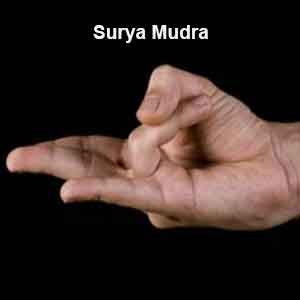
How to do Surya (Soorya) Mudra
- Sit comfortably in any yoga asana, such as Sukhasana or Padmasana. Be sure to align your back, neck and head.
- Place the hands on the knees and keep the palms facing up.
- Gently close your eyes and take deep breaths.
- Press your ring finger to the base of your thumb and use your thumb to apply gentle pressure on the second phalanx of the ring finger.
- The other three fingers should remain straight and extended.
Practice Surya Mudra for at least 45 minutes daily to get the best results. You can practice this with 15-minute sessions three times a day.
Benefits of Surya Mudra
- It helps invigorate the body and mind and improves concentration and focus.
- Surya mudra helps to boost metabolism and increases the vitality of the body.
- Because of its nature of increasing fire element in the body, Surya mudra improves digestion and hence aids in weight loss.
- Surya mudra helps to maintain body temperature during the winter season and prevents problems such as cold and cough, dry skin, sore throat, joint pain, etc.
- The Surya mudra can also help increase energy and vigor, which overcome feelings of lethargy or exhaustion.
(9) – Prithvi Mudra (Psychic gesture of earth element)
The Prithvi mudra is associated with the earth element and is great for grounding the body and mind.

How to do Prithvi Mudra
- Prithvi mudra can be done while sitting comfortably in a yoga posture with your hands resting on your knees.
- Gently fold your ring finger’s tip toward your thumb’s tip to connect, keeping the rest of the fingers spread straight.
- This mudra is done by pressing your index finger to the base of your thumb using your thumb to apply pressure.
- The other three fingers should remain straight and extended.
Prithvi Mudra should ideally be practiced daily for at least 30 to 45 minutes at one go or thrice a day for 10-15 minutes.
Benefits of Prithvi Mudra
- Prithvi mudra is helpful for people who want to gain weight.
- It helps promote feelings of stability, security, and balance.
- Prithvi mudra helps to reduce hair fall and premature greying of hair because of proper blood circulation.
- Prithvi Mudra governs the earth element associated with our skin and nails, so it helps to improve the texture of the skin and nails.
- Prithvi Mudra makes you feel grounded and connected to life by practising it with meditation.
Even though Prithvi Mudra is a very easy hand gesture to practice, its contraindications must be read and kept in mind in order to do it safely.
(10) – Adi Mudra ( First Gesture)
The Adi mudra, also known as “first gesture”, is associated with the element of space and is great for promoting clarity and calmness. The Sanskrit word “adi” means ‘primal’ or that which existed initially, as it is the first indication that embryos can form inside the womb or as infants.
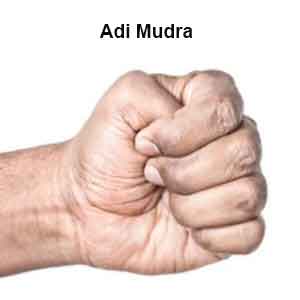
How to do Adi Mudra
- Begin the practice of Adi Mudra by sitting in a yoga posture like Sukhasana, Padmasana or Vajrasana. Make sure the head, neck and spine are straight.
- Place the palms facing up on the knees. Close your eyes and focus on your breathing pattern.
- Now fold the thumb in the palm so that the tip of the thumb touches the base of the little finger. Wrap all other fingers to cover the thumb, making a light fist.
Adi Mudra should be practiced continuously for 30 minutes or for a period of 10 minutes thrice a day.
Benefits of Adi Mudra
- Adi Mudra helps in increasing the flow of oxygen in the body.
- Adi Mudra helps in increasing the capacity of the lungs.
- It helps calm the mind, reduce stress, and improve concentration and focus.
- The Adi mudra can also help cultivate feelings of serenity and inner peace.
(11) – Anjali Mudra (Gesture of Reverence)
The Anjali mudra is associated with the element of air and is used to express reverence and gratitude.
Anjali is a Sanskrit word meaning “offering” or “salutation” and is often used for respectful greetings in most Asian countries. In India, this gesture accompanies the word “namaste or namaskar” to greet, respect, salute others and pray to the divinity.
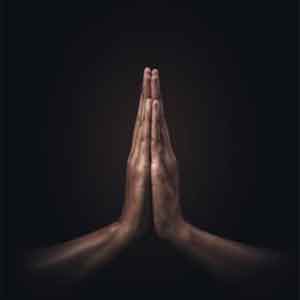
How to do Anjali Mudra
- Sit in a comfortable position taking any yoga pose such as Sukhasana.
- Lengthen your spine, aligning the head and neck with the back.
- Bring your palms together before the center of your chest and in front of The Heart Chakra. Bring all your awareness to your heart, allowing energy to flow from other points in your body to your heart center.
- Press the palms together firmly and gently while keeping your fingers pointing up.
- Close your eyes to bring all the awareness inward.
- Take deep breaths, stay in the pose for a few minutes, and feel the vibrations at the points of joining palms.
Benefits of Anjali Mudra
- Anjali Mudra helps in strengthening the muscles of wrists and arms.
- It helps promote feelings of peace, respect, and appreciation.
- It also helps promote the inner-awareness.
- Anjali Mudra brings both the hemispheres of our brain together, which helps develop a positive thought process during practice.
- The Anjali mudra can also help cultivate a sense of humility and connectedness with the divine.
- Anjali Mudra stimulates the Anahata Chakra located at the center of the chest, which helps us deal with our emotions more efficiently.
(12) – Dhyana Mudra (Psychic gesture of Meditation)
The Dhyana mudra is associated with the element of fire and is used to invoke a state of inner stillness and meditation. This hand gesture is also known as Samadhi Mudra, Meditation Mudra and Yoga Mudra.

How to do Dhyana Mudra
- Sit comfortably in Sukhasana, Padmasana, or any other meditative sitting posture. You can also sit on a chair if you feel uncomfortable sitting cross-legged.
- Place your hands in your lap with your palms facing up and keep one palm on the other. You can put the left palm on the right or the right palm on the left; both variations are fine.
- Connect the tips of the thumbs, lightly touching them to form a triangle.
- Close your eyes and take a few deep breaths, focusing your awareness on your breath.
- Hold the Meditation or Dhyana Mudra for 20 minutes.
Benefits of Dhyana Mudra
- In Sanskrit, Dhyana means meditation, so Dhyana Mudra holds an important place for yogis who wish to achieve spiritual progress through meditation.
- It also brings positivity and purity in thoughts, thus helping in attaining peace.
- Meditation pose removes stress and anxiety from the mind and body, thereby keeping your mind calm.
- Dhyana mudra can help in increasing memory power which increases knowledge.
- Dhyana mudra, with meditation, helps gain deeper insight and create greater self-awareness.
- It helps to promote feelings of inner peace, clarity, and focus.
(13) – Shakti Mudra (Psychic gesture of Power)
The Shakti mudra is associated with the element of fire and invokes a sense of personal power and strength. The literal meaning of Shakti is strength or power and is often related to Goddess Durga in Hinduism.

How to do Shakti Mudra
- Sit in any meditative yoga asana or comfortable sitting position.
- Bring both palms together and rub gently to energize the palms.
- Fold your thumbs in the palms.
- Gently fold your index and middle fingers over your thumbs such that they wrap the thumbs.
- Now, connect the tips of the little and ring fingers together, keeping them straight and extended.
- Hold the mudra for 15-30 minutes daily.
- While practicing combine the mudra with mantra chanting for more energy.
Benefits of Shakti Mudra
- The Shakti mudra can help cultivate a sense of courage and resilience.
- Shakti mudra is believed to direct the energy to the pelvic area, which helps to relax all the problems in that area of the body.
- Shakti Mudra helps in dealing with all sleep-related disorders and cures insomnia.
- It helps to promote feelings of self-confidence and inner strength.
- Shakti mudra helps in strengthening the immune system.
(14) – Hakini Mudra (Sacred Hand Gesture)

The Hakini mudra is associated with the element of air and is used to invoke a sense of mental clarity and focus.
- This mudra is done by placing your hands in front of you with the palms facing each other.
- The thumbs should be lightly touching.
- It helps to promote feelings of mental clarity and concentration.
- The Hakini mudra can also be used to help cultivate a sense of mental balance and harmony.
(15) – Apāna Mudra (Psychic gesture of life force)
The Apāna mudra is associated with the element of water and invokes a sense of vitality and energy.
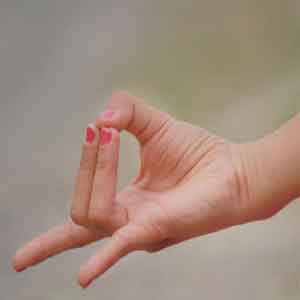
- This mudra is done by placing your hands in front of you with the palms facing up.
- The index fingers should touch each other at the ends.
- It helps to promote feelings of vitality and energy.
- The Apāna mudra can also be used to help cultivate a sense of physical health and well-being.
(16) – Poorna Mudra/Brahma Mudra (Gesture of full breath)
The Poorna mudra is associated with the element of fire, and it invokes a sense of courage and resilience.

- This mudra is done by placing your hands in front of you with the palms facing down.
- The index fingers should touch each other at the ends.
- It helps to promote feelings of courage and resilience.
- The Poorna mudra can also be used to help cultivate a sense of strength and determination.
(17) – Yoni Mudra (Attitude of the womb)
The Yoni mudra is associated with the element of earth and is used to invoke a sense of grounding and stability.

- This mudra is done by placing your hands in front of you with the palms facing each other.
- The index fingers should touch each other at the ends.
- It helps to promote feelings of grounding and stability.
- The Yoni mudra can also be used to help cultivate a sense of inner peace and security.
(18) – Bhairav Mudra (Fierce or terrifying attitude)
The Bhairav mudra is associated with the element of air and is used to invoke a sense of power and strength.
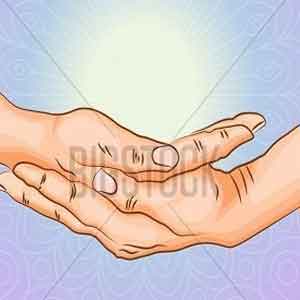
- This mudra is done by placing your hands in front of you with the palms facing up.
- The index fingers should touch each other at the ends.
- It helps to promote feelings of power and strength.
- The Bhairav mudra can also be used to help cultivate a sense of self-confidence and courage.
(19) – Hridaya Mudra (Heart Gesture)
The Hridaya mudra is associated with the element of water and is used to invoke a sense of love and compassion.

- This mudra is done by placing your hands in front of you with the palms facing each other.
- The index fingers should touch each other at the ends.
- It helps to promote feelings of love and compassion.
- The Hridaya mudra can also be used to help cultivate a sense of openness and understanding.
(20) – Vishnu Mudra (Hand gesture of Lord Vishnu)
The Vishnu mudra is associated with the element of earth and is used to invoke a sense of stability and protection.
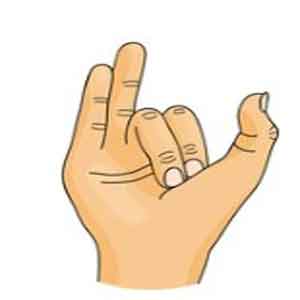
- This mudra is done by placing your hands in front of you with the palms facing up.
- The index fingers should touch each other at the ends.
- It helps to promote feelings of stability and protection.
- The Vishnu mudra can also be used to help cultivate a sense of grounding and security.
(21) – Granthita Mudra (Knot gesture)
The Granthita mudra is associated with the element of fire and is used to invoke a sense of passion and drive.

- This mudra is done by placing your hands in front of you with the palms facing each other.
- The index fingers should touch each other at the ends while the thumbs are crossed over them.
- It helps to promote feelings of passion and drive.
- The Granthita mudra can also be used to help cultivate a sense of determination and ambition.
(22) – Mahasir Mudra (Great head gesture)
The Mahasir mudra is associated with the element of air and is used to invoke a sense of openness and understanding.
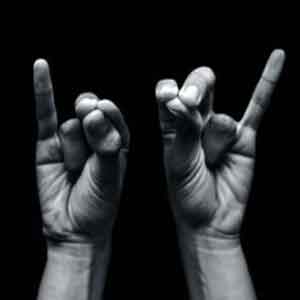
- This mudra is done by placing your hands in front of you with the palms facing up.
- The index fingers should touch each other at the ends while the thumbs should be placed in a cross position over them.
- It helps to promote feelings of openness and understanding.
- The Mahasir mudra can also be used to help cultivate a sense of clarity and insight.
Hasta Yoga Mudra Practices and Techniques
Hasta Yoga mudras are a powerful practice that can be used to help promote physical, mental and emotional well-being. Here are some tips to get you started with your yoga mudra practice:
- Start with a comfortable seated position and take some deep breaths.
- Focus on the mudra that you have chosen and the corresponding elements or qualities associated with it.
- Close your eyes and begin to move through the mudra slowly and deliberately, paying attention to how it feels in your body.
- Hold each mudra for several minutes at a time, allowing yourself to sink into the pose.
- When you’re finished, take a few moments to sit quietly and observe any changes or sensations that arise in your body or mind as a result of practicing the mudra.
Conclusion
Hasta Yoga mudras are powerful tools for promoting physical, mental, and emotional well-being. They can be used to cultivate feelings of peace, stillness, and connection with your inner self.
With regular practice, you can use yoga mudras to tap into your healing potential while also strengthening your body and mind.
Read More Articles
What is Kundalini Yoga?
7 Benefits of Mantra Chanting
Join Our Facebook Page



